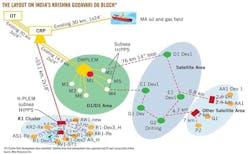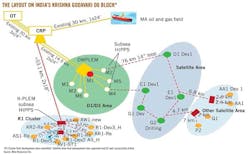Reliance Industries Ltd., BP PLC, and Niko Resources Ltd. have outlined $5 billion in development and exploratory work to the Indian government to hike gas production on the deepwater KG D6 block off the country's eastern coast.
RIL as operator is responding to pressure from India's Ministry of Petroleum and Natural Gas to drill more wells on the block because production fallen below projections made in the production sharing contract. The operator blames the underperformance on reservoir complications.
The newly proposed projects, which require government approval, involve developing 4 tcf of discovered gas and exploring for more.
By the end of 2012, fields in the D6 block had produced 2 tcf of gas and 22 million bbl of oil.
The companies will deploy advanced skills, processes, and technologies through the combined partnership to produce gas from more than 1,500 m of water.
Higher prices may help
The prospect exists for higher allowed prices for gas from the block, where the three-company group is looking at restarting flow from certain wells and developing other parts of the block, Niko said.
However, Niko said it expects D6 gas production to continue to decline until new field production is added from identified development opportunities. Reliance operates D6 and the NEC-25 block farther north with a 60% interest, a BP unit has 30%, and Niko has 10%.
The group decreased its D6 reserve estimates last year due to the disappointing reservoir performance (OGJ Online, Aug. 13, 2012).
Niko said, "The business environment in India appears to have improved significantly as evidenced by the release of a government-appointed committee's report on domestic gas pricing and the restart of planned development and exploration activities for the D6 block in India."
A December 2012 report by the Rangarajan committee to the government of India included a recommendation on a pricing mechanism for natural gas produced in India that at current inputs would increase the price to $8-8.50/MMbtu compared with the $4.20/MMbtu D6 gas now fetches, Niko said.
The group submitted the field development plan for an additional area on D6 in January and will submit the plan for a development on NEC-25 by March.
Niko added, "With field development plans submitted and increased clarity on future gas prices for the developments, the company expects to book a substantial portion of its approximately 600 bcf of estimated contingent resources as reserves, effective Mar. 31, 2013."
D6 performance
After the D6 production-sharing contract was signed in 2000, exploration led to discovery of Dhirubhai 1 and 3 gas fields in 2002 and MA oil and gas field in 2006, Niko noted.
Crude oil production from MA field began in September 2008, and commercial output started in May 2009 on the 7,645 sq km block 20 km offshore eastern India. Six wells are tied into a floating production, storage, and offloading vessel, four of which are on production.
The group expects to drill an additional gas development well and convert the two suspended oil wells into gas producing wells to accelerate recovery of the reservoir's gas reserves.
The group drilled 18 wells at Dhirubhai 1 and 3 fields, where gas production began in April 2009 and commercial output started in May 2009. The produced gas is received at an onshore facility at Gadimoga and sold at the inlet to the East-West Pipeline owned by Reliance Gas Transportation Infrastructure Ltd.
Dhirubhai 1 and 3 gas output peaked in March 2010 and has decreased since then, primarily due to natural declines of the fields and greater than anticipated water production, Niko said.
Four more wells have been drilled in the post-production phase of drilling. Based on the information obtained from three wells drilled in the main channel fairway, Niko determined that it is not economic to tie-in any of the three wells at present. The fourth, drilled outside of the main channel fairway, did not encounter economic quantities of gas.
Eight of the original 18 wells are shut-in, and several others are choked, mainly due to current constraints in water handling capacity.
D6 gross sales volumes were 88 MMcfd of gas equivalent for the 3 months and 104 MMcfd of gas equivalent in the 9 months ended Dec. 31, 2012, Niko said, compared with 151 MMcfed and 167 MMcfed in the corresponding prior year periods.
D6, NEC-25 prospects
Reliance and the joint venture partners are evaluating workover scenarios to bring some of the D6 shut-in wells back online in the coming year. Increased water handling capacity and booster compression are expected to be installed over the next 2 years to address the decline in reservoir pressure.
An exploration program has identified three other areas on D6 for potential future development, Niko said. In January, the G2 well on the D19 discovery, one of four satellite discoveries approved for development by the government, was successfully drilled and the development plan for the R-Series area was submitted to the government for approval.
Development of these areas is expected to be completed within 4 years after the approval of the development plans. The plans are likely to include the reentry and completion of certain existing wells and the drilling of new wells, all connected with new flowlines and other facilities into existing D6 block infrastructure (Fig. 1).
On the 9,461 sq km NEC-25 block, exploration and appraisal drilling has been conducted and Reliance is working to finalize the development plan for discovered gas fields by next month, Niko said.
Based on work done to date, the development is expected to include the reentry and completion of certain existing wells and the drilling of new wells, all connected via new flowlines and other facilities into a new offshore central processing platform. The produced gas is expected to be transported onshore via a new pipeline.


